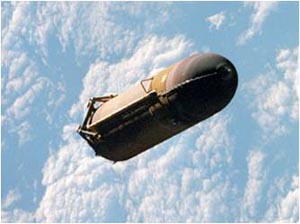History of NASA’s External Tank
The External Tank (ET) was the “gas tank” for the Orbiter; it contained the propellants used by the Space Shuttle Main Engines. It was also considered the “backbone” of the Shuttle during the launch, providing structural support for attachment with the solid rocket boosters and orbiter.
The three main components of the External Tank were an oxygen tank, located in the forward position, an aft-positioned hydrogen tank, and a collar-like intertank, which connected the two propellant tanks, houses instrumentation and processing equipment, and provided the attachment structure for the forward end of the solid rocket boosters.
When the Solid Rocket Boosters separated at an altitude of approximately 45 kilometers (28 miles), the orbiter, with the main engines still burning, carried the external tank piggyback to near orbital velocity, approximately 113 kilometers (70 miles) above the Earth. Once the tank became nearly empty, it separated from the Orbiter and fell (in a preplanned trajectory) while the majority of it disintegrated in the atmosphere and the rest fell into the ocean.
The tank was the only component of the Space Shuttle that was not reused. Approximately 8.5 minutes into the flight, with all of its propellant used, the tank was jettisoned.
For more information on the External Tank, click here.


























